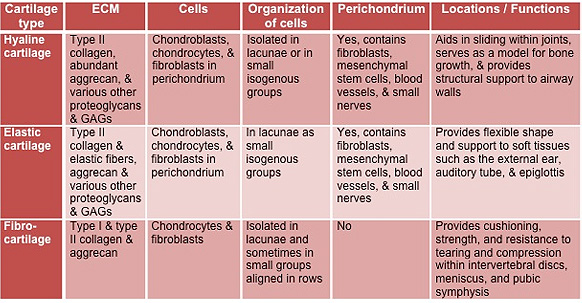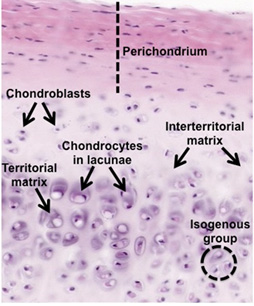|
Cartilage is a specialized,
semi-rigid connective tissue characterized by the predominance of a
glycosaminoglycan and proteoglycan-rich ground substance that
attracts water, giving this tissue a high degree of hydration. The
extracellular matrix contains varying amounts and types of
connective tissue fibers, giving rise to three main types of
cartilage: hyaline, elastic, and fibrocartilage. Compare and
contrast the properties and functions of the three types of
cartilage as described in the table below.

Hyaline cartilage, the most
common type of cartilage, contains the smallest proportion of
fibrous material in its abundant ground substance. As its name
implies, it is glassy or translucent in appearance due to the
properties of its extracellular matrix. Examine the cartilage in the
trachea and in
this trichrome stained
slide of the larynx. and in
this trichrome stained
slide of the larynx.
 In
these slides and as shown in the image at the right, identify: In
these slides and as shown in the image at the right, identify:
- Perichondrium
- Chondroblasts
- Chondrocytes
- Lacunae
- Isogenous groups
- Territorial/Intraterritorial
matrix
- Click here for a
larger,
printable image
Clinical note: The
avascularity of cartilage limits its size according to the
distance small molecules can diffuse through the matrix to
nourish the chondrocytes. The matrix is a barrier to the entry
of large proteins like immunoglobulins and also to lymphocytes,
which is important for the practice of reconstructive and
cosmetic surgery since cartilage can be transplanted from one
individual to another without rejection by the immune system.
Next, let's compare hyaline cartilage
to elastic and fibrocartilage. |